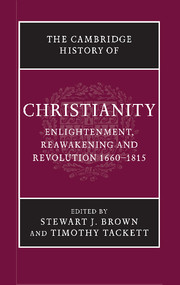Book contents
- Frontmatter
- Introduction
- PART I CHURCH, STATE, AND SOCIETY IN THE EUROPEAN WORLD, 1660–1780
- PART II CHRISTIAN LIFE IN THE EUROPEAN WORLD, 1660–1780
- 5 The Catholic clergy in Europe
- 6 The Protestant clergies in the European world
- 7 Reaching audiences: Sermons and oratory in Europe
- 8 Christian education
- 9 Christianity and gender
- 10 Popular religion
- 11 Jewish–Christian relations
- 12 Architecture and Christianity
- PART III MOVEMENTS AND CHALLENGES
- PART IV CHRISTIAN DEVELOPMENTS IN THE NON-EUROPEAN WORLD
- PART V REVOLUTION AND THE CHRISTIAN WORLD
- Chronology
- Bibliography
- Index
- References
7 - Reaching audiences: Sermons and oratory in Europe
from PART II - CHRISTIAN LIFE IN THE EUROPEAN WORLD, 1660–1780
Published online by Cambridge University Press: 28 March 2008
- Frontmatter
- Introduction
- PART I CHURCH, STATE, AND SOCIETY IN THE EUROPEAN WORLD, 1660–1780
- PART II CHRISTIAN LIFE IN THE EUROPEAN WORLD, 1660–1780
- 5 The Catholic clergy in Europe
- 6 The Protestant clergies in the European world
- 7 Reaching audiences: Sermons and oratory in Europe
- 8 Christian education
- 9 Christianity and gender
- 10 Popular religion
- 11 Jewish–Christian relations
- 12 Architecture and Christianity
- PART III MOVEMENTS AND CHALLENGES
- PART IV CHRISTIAN DEVELOPMENTS IN THE NON-EUROPEAN WORLD
- PART V REVOLUTION AND THE CHRISTIAN WORLD
- Chronology
- Bibliography
- Index
- References
Summary
During the ‘long’ eighteenth century, the social and intellectual pressures brought to bear on the sermon as a medium of communication were stronger than ever before. Other channels – the newspaper, the journal, the novel, the public lecture, the coffee house, the debating club, the learned society – were rapidly appropriating its educational and moralizing functions, while audiences were beginning to shift their attention elsewhere. Nevertheless, the sermon remained a chief conduit of public instruction throughout the period, its presence prominent, its appearance varied. The following account is divided into four sections. ‘Manifestation’ describes the general appearance of the sermon between 1660 and 1800; ‘Aspiration’ examines its aims; ‘Tradition’ discusses the confessional type of sermon; and ‘Transformation’ outlines the successful response of the eighteenth-century sermon to the challenges it faced.
Manifestation
Sermons still catered mostly to organized groups of hearers gathered in a church, but throughout the period there were notorious instances of informal assembly, including the Pietist conventicle and the revivalist gathering. Pietist lay preachers such as the Norwegian Hans Nielsen Hauge (1771–1824) travelled considerable distances on foot to preach, in violation of the law, and he was frequently imprisoned for doing so. Female preachers too could be found outside the dominant institutions, among Quakers and nonconforming Pietists, and in private enclaves within churches, especially among evangelicals. Whilst the place of venue was usually a church – public or clandestine – it might just as well have been a field, a park, a public hall, or a marketplace. Wesley turned to the open air when he found the Anglican pulpit closed to him, and he persisted in doing so, three or four times a day, for half a century until he was eighty-eight years of age.
- Type
- Chapter
- Information
- The Cambridge History of Christianity , pp. 128 - 146Publisher: Cambridge University PressPrint publication year: 2006
References
- 1
- Cited by



